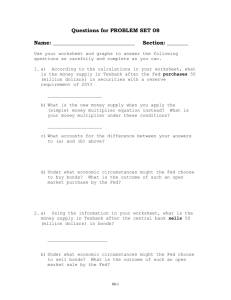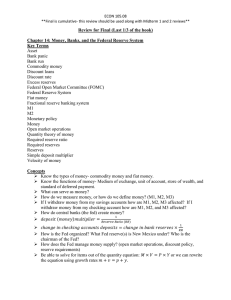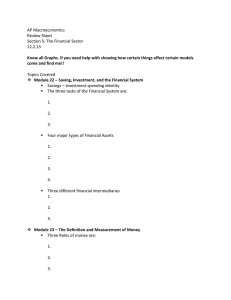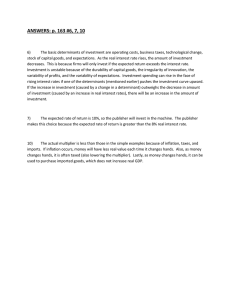Money and Financial Markets Assets and Liabilities
advertisement
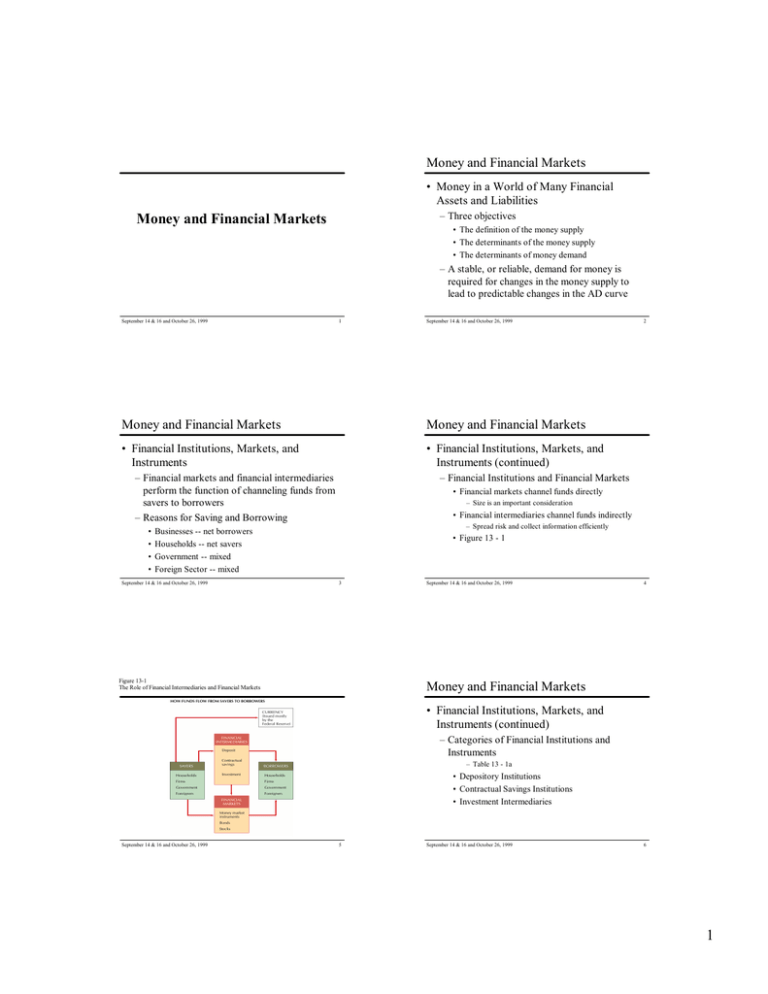
Money and Financial Markets
• Money in a World of Many Financial
Assets and Liabilities
– Three objectives
Money and Financial Markets
• The definition of the money supply
• The determinants of the money supply
• The determinants of money demand
– A stable, or reliable, demand for money is
required for changes in the money supply to
lead to predictable changes in the AD curve
September 14 & 16 and October 26, 1999
1
September 14 & 16 and October 26, 1999
Money and Financial Markets
Money and Financial Markets
• Financial Institutions, Markets, and
Instruments
• Financial Institutions, Markets, and
Instruments (continued)
– Financial markets and financial intermediaries
perform the function of channeling funds from
savers to borrowers
– Reasons for Saving and Borrowing
– Financial Institutions and Financial Markets
• Financial markets channel funds directly
– Size is an important consideration
• Financial intermediaries channel funds indirectly
– Spread risk and collect information efficiently
• Businesses -- net borrowers
• Households -- net savers
• Government -- mixed
• Foreign Sector -- mixed
September 14 & 16 and October 26, 1999
2
• Figure 13 - 1
3
Figure 13-1
The Role of Financial Intermediaries and Financial Markets
September 14 & 16 and October 26, 1999
4
Money and Financial Markets
• Financial Institutions, Markets, and
Instruments (continued)
– Categories of Financial Institutions and
Instruments
– Table 13 - 1a
• Depository Institutions
• Contractual Savings Institutions
• Investment Intermediaries
September 14 & 16 and October 26, 1999
5
September 14 & 16 and October 26, 1999
6
1
Money and Financial Markets
Money and Financial Markets
• Financial Institutions, Markets, and
Instruments (continued)
• Definitions of Money
– Introduction
• There is a spectrum of financial assets running the
gamut of medium-of-exchange to store-of-value
• Financial deregulation has blurred the distinction
between different kinds of financial assets
– Financial Market Instruments
– Table 13 - 1b
• Money Market Instruments
– Original maturities of one year or less
• Capital Market Instruments
– Original maturities of more than one year
September 14 & 16 and October 26, 1999
7
September 14 & 16 and October 26, 1999
Money and Financial Markets
Money and Financial Markets
• Definitions of Money (continued)
• Definitions of Money (continued)
– The M1 Definition of Money
8
– The M2 Definition of Money
– Table 13 - 2
– Table 13 - 2
• Currency
• Transactions accounts
• Travelers checks
• M1
• Savings deposits
• Time deposits
• Money market mutual funds
– Excluded from M2 are mutual funds and all
money and capital market instruments
September 14 & 16 and October 26, 1999
9
September 14 & 16 and October 26, 1999
Money and Financial Markets
Money and Financial Markets
• Definitions of Money (continued)
• High-Powered Money and Determinants of
the Money Supply
– Money Supply Definitions and the Instability of
Money Demand
• The demand for M2 may shift unpredictably when
these omitted assets become more attractive relative
to the assets that are included in M2
September 14 & 16 and October 26, 1999
11
10
– Money Creation on a Desert Island
• An example
September 14 & 16 and October 26, 1999
12
2
Money and Financial Markets
Money and Financial Markets
• High-Powered Money and Determinants of
the Money Supply (continued)
• High-Powered Money and Determinants of
the Money Supply (continued)
– Required Conditions for Money Creation
– The Money-Creation Multiplier
• Equivalence of coins and deposits
• Redeposit of proceeds from loans
• Holding of cash reserves
• Willing borrowers
• Introduction
– High-powered money is the sum of currency held outside
of depository institutions and the reserves held in them
– The demand for high-powered money to be held as
reserves equals the supply of high-powered reserves
– If banks stop lending their excess reserves, the process of
money creation would stop
September 14 & 16 and October 26, 1999
13
e*D=H
D=H/e
September 14 & 16 and October 26, 1999
Money and Financial Markets
Money and Financial Markets
• High-Powered Money and Determinants of
the Money Supply (continued)
• High-Powered Money and Determinants of
the Money Supply (continued)
– The Money-Creation Multiplier (continued)
– The Money-Creation Multiplier (continued)
• Comparison with Income-Determination Multiplier
14
• Comparison with Real-World Conditions
– The intuition behind the money-creation multiplier is the
same as the income-determination multiplier
– e reflects the leakages from the money creation process
– Need to keep everything in the banking system
• Cash Holdings
– Multiplier changes as cash leaks out of the system
(e*D)+(c*D)=H
(e+c)*D=H
D=H/(e+c)
September 14 & 16 and October 26, 1999
15
September 14 & 16 and October 26, 1999
Money and Financial Markets
Money and Financial Markets
• High-Powered Money and Determinants of
the Money Supply (continued)
• High-Powered Money and Determinants of
the Money Supply (continued)
– The Money-Creation Multiplier (continued)
16
– Gold Discoveries and Bank Panics
• Cash Holdings (continued)
• Can change H, c, or e
M=D+c*D=(1+c)*D
M=(1+c)*D={(1+c)*H}/(e+c)
– The ratio of the money supply to high-powered money
( M / H ) is called the money multiplier
M/H=(1+c)/(e+c)
– There is a separate money multiplier for each definition of
the money supply
September 14 & 16 and October 26, 1999
17
September 14 & 16 and October 26, 1999
18
3
Money and Financial Markets
Money and Financial Markets
• The Fed’s Three Tools for Changing the
Money Supply
• The Fed’s Three Tools for Changing the
Money Supply (continued)
– In order to control the money supply the Fed
must predict the public’s desired cash-holding
ratio ( c ), over which the Fed has no control.
– Then the Fed can adjust H and e to make its
desired M consistent with the public’s chosen c
– First Tool: Open-Market Operations
• Purchases and sales of government securities made
by the Federal Reserve
• H is Created out of Thin Air
• Effect on Interest Rates
– Sometimes the Fed engages in open-market operations
even when it has no desire to raise or lower the money
supply
September 14 & 16 and October 26, 1999
19
September 14 & 16 and October 26, 1999
Money and Financial Markets
Money and Financial Markets
• The Fed’s Three Tools for Changing the
Money Supply (continued)
• The Fed’s Three Tools for Changing the
Money Supply (continued)
– Second Tool: Discount Rate
20
– Third Tool: Reserve Requirements
• The interest rate the Federal Reserve charges
depository institutions when they borrow reserves
• Most an emergency tool
• The minimum fraction of deposits that must be held
as reserves
– Required reserves
– Held in reserve accounts at the Fed or as vault cash
• The Fed can change the money supply by changing
bank reserve requirements, e
• Banks would hold some reserves even without
reserve requirements but they would be much less
September 14 & 16 and October 26, 1999
21
September 14 & 16 and October 26, 1999
Money and Financial Markets
Money and Financial Markets
• The Fed’s Three Tools for Changing the
Money Supply (continued)
• Theories of the Demand for Money
22
– Introduction
• Understand why the demand for money depends on
the interest rate available on assets that are
alternatives to money
• Understand why the demand for money might shift
in response to financial deregulation or other events
– Why the Fed Can’t Control the Money Supply
Precisely (Money-Multiplier Shocks)
• Multiple Definitions of Money
• The Public Chooses the Amount of Currency
– Foreigners
• Deposit Shifts between Reserve Categories
September 14 & 16 and October 26, 1999
23
September 14 & 16 and October 26, 1999
24
4
Figure 13-2 Alternative Allocations of an Individual’s Monthly Paycheck Between Cash and
Savings Deposits
Money and Financial Markets
• Theories of the Demand for Money (con’t)
– Interest-Responsiveness of the Transactions
Demand for Money (continued)
• Introduction
– Transaction demand for money depends on interest rate
– Funds can be held either in M1 or in savings accounts
» Figure 13 - 2
• Costs and Benefits of Holding Money
September 14 & 16 and October 26, 1999
25
September 14 & 16 and October 26, 1999
Money and Financial Markets
Money and Financial Markets
• Theories of the Demand for Money (con’t)
• Theories of the Demand for Money (con’t)
– Interest-Responsiveness of the Transactions
Demand for Money (continued)
26
– The Portfolio Approach
• Tobin’s Contribution
– Households diversify their holdings of financial assets
between risky and risk-free assets
– Does not explain why anyone holds currency or noninterest bearing checking accounts when alternatives are
available
• How Many Trips to the Bank?
Cost = b * T + ( r * C ) / 2
– The combined cost of broker’s fees and interest income
foregone should be minimized
Cost = b * ( Y / C ) + ( r * C ) / 2
• Friedman’s Version
– It can be shown that cash is minimized when
– Portfolio needs to include a broader array of assets
C = { ( 2 * b * Y ) / r } * 0.5
September 14 & 16 and October 26, 1999
27
September 14 & 16 and October 26, 1999
Money and Financial Markets
Money and Financial Markets
• CASE STUDY:
How Financial Deregulation and Innovation
Steepened the IS and LM Curves
• CASE STUDY (continued)
– Deregulation of financial markets can increase
the volatility of interest rates
September 14 & 16 and October 26, 1999
29
28
– Effects of Regulation Q
• Disintermediation, the effect on interest rates,
mortgage financing, and housing activity
September 14 & 16 and October 26, 1999
30
5
Figure 13-3
The Effect of Financial Deregulation in the Commodity and Money Markets
Money and Financial Markets
• CASE STUDY (continued)
– Financial Deregulation and the IS Curve
• Financial deregulation and innovations
–
–
–
–
Repeal of Req. Q
Introduction of interest-sensitive deposit accounts
Development of the mortgage-backed securities
Introduction of adjustable-rate mortgages
• Because disintermediation no longer stymies
spending, larger increases in interest rates are now
required to reduce spending by the same amount
» Figure 13 - 3a
September 14 & 16 and October 26, 1999
31
September 14 & 16 and October 26, 1999
Money and Financial Markets
Money and Financial Markets
• CASE STUDY (continued)
• CASE STUDY (continued)
– Why the LM Curve Became Steeper
– Effects on Interest Rates
• Financial deregulation and innovations
• The main effect of deregulation is likely to be
increased volatility of interest rates
– Introduction of interest bearing substitutes
– Development of mutual funds
» Figure 13 - 3b
September 14 & 16 and October 26, 1999
32
» Figure 13 - 4
• Deregulation can have adverse side effects that may
partially offset the benefits of greater efficiency and
fairness when prices play the main role in balancing
supply and demand in financial markets
33
Figure 13-4
The Effect of a Lower Money Supply on Interest Rates and Output
September 14 & 16 and October 26, 1999
34
Money and Financial Markets
• Why the Fed “Sets” Interest Rates
– Introduction
• Pervasive deregulation and innovation in financial
markets were apparently major contributors to the
frequent instability of the demand for money
• Sometimes the IS and LM curves will shift
unpredictably for reasons unrelated to financial
deregulation and innovation
• Large, frequent, and continuing instability of the
demand for money has led the Fed shift its focus
from the money supply to interest rates
September 14 & 16 and October 26, 1999
35
September 14 & 16 and October 26, 1999
36
6
Figure 13-5 Effects on Real Output of Policies That Either Stabilize the Interest Rate or Stabilize
the Real Money Supply When Either Commodity Demand or Money Demand is Unstable
Money and Financial Markets
• Why the Fed “Sets” Interest Rates (con’t)
– Introduction (continued)
• Show why the unpredictability, or instability, of the
demand for money led the Fed to shift its policies
toward setting interest rates
• Cannot set interest rates
– Only influence rates through open market operations
• Figure 13 - 5
– When commodity demand is unstable the IS curve shifts
back and forth
– When the demand for money is unstable the LM curve
shifts back and forth
September 14 & 16 and October 26, 1999
37
September 14 & 16 and October 26, 1999
Money and Financial Markets
Money and Financial Markets
• Why the Federal Reserve “Sets” Interest
Rates (continued)
• Why the Federal Reserve “Sets” Interest
Rates (continued)
– Introduction (continued)
– Introduction (continued)
• Implications of Unstable Commodity Demand
• The Analysis with Unstable Money Demand
» Figure 13 - 5a
– Targeting money supply
– Targeting interest rates
– Targeting real GDP
September 14 & 16 and October 26, 1999
38
» Figure 13 - 5b
– Targeting money supply
– Targeting interest rates
– Targeting real GDP
39
September 14 & 16 and October 26, 1999
40
Money and Financial Markets
• Why the Federal Reserve “Sets” Interest
Rates (continued)
– The Case for a GDP Target
• Real GDP targeting is best for either:
– Unstable commodity demand
– Unstable demand for money
• With supply shocks
– Targeting nominal GDP leads to lower real GDP
– Targeting real GDP leads to higher inflation
» Accommodating monetary policy
September 14 & 16 and October 26, 1999
41
7



